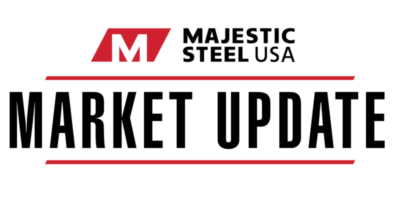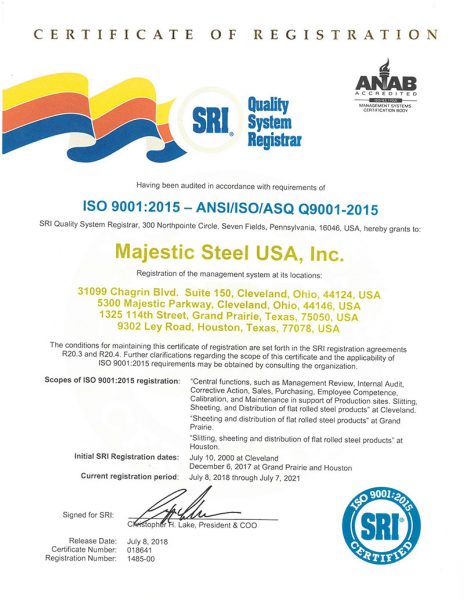Market Update | February 2, 2022
MANUFACTURING DEMAND CONTINUES TO INCREASE
The most recent reading from the ISM Manufacturing Index showed continued growth in economic activity for January. This is the 20th consecutive month of growth. In the Chicago area, manufacturing activity reached its highest reading since October and has increased for 19 straight months. Additionally, total construction spending continues to increase, setting new all-time highs each month for the last 10 months.
INPUT COSTS
Zinc pricing remained firm this week after a sharp increase to start the new year.
– Zinc pricing remained near $1.65/lb this week; holding at that level since the week before Christmas.
– However, longer-term forecasts expect pricing to return to the recent $1.40/lb.-$1.45/lb. average.
Spot iron ore pricing was virtually flat this week, holding at $137.80/dmt.
– While spot iron ore pricing is virtually flat w/w, pricing is still up 17.0% m/m.
Pacific basin met coal pricing continued to climb this week, hitting a fresh all-time high.
– Met coal pricing climbed to $444/mt, up 8.6% from last week.
– Pricing is also up 29.6% m/m and up 237% y/y.
Weaker sheet mill order books, increased imports (finished, semi, and scrap), and continued uncertainty around the auto industry have helped prime scrap pricing to soften further in February.
– Early indications are for prime scrap pricing to slide an additional $30-$50/gt during the February buy week.
SUPPLY
After climbing the previous two weeks, domestic raw steel production slipped for the second consecutive week.
– U.S. steelmakers produced 1.796 million tons at an 81.6% utilization rate.
– This was the lowest weekly output since mid-May.
– Year-to-date production is 3.5% above the total from the same period last year.
Based on preliminary import license data, the daily average of imports for January, is down 1.7% compared to the pace through the same timeframe in December.
– Excluding Brazilian slabs, the daily average in January is down 3.8% from December.
Nucor announced it will invest $290m to add value-add finishing at its Crawfordsville Indiana sheet mill.
– The expansion at Crawfordsville, will raise the construction grade continuous galvanizing line to a capacity of 300K tons/year while the pre-paint line will have an annual capacity of 250K tons/year.
– They say the expansion will take two years to complete.
DEMAND
Manufacturing activity in the Chicago area continued to increase in January, now showing expansion for the nineteenth consecutive month.
– The Chicago PMI came in at 65.2 in January, up from a revised 64.3 in December and is at its highest level since October.
– Any reading over 50.0 indicates an expansion in activity, while any reading below 50.0 indicates a decline in activity.
– Of the five main components, order backlogs, employment, and supplier deliveries all increased.
– The production and new orders components slipped however.
Total construction spending continued to climb, on a seasonally adjusted basis, in December; now up for the tenth consecutive month.
– Construction spending came in at a $1.639 trillion rate in December, up 0.2% from November and up 9.0% from a $1.504 trillion rate in December 2020.
– Construction spending continues to set all-new highs each month.
– While non-residential construction slipped on a month-over-month basis (-0.7%), the 1.1% increase in residential spending was more than enough to overcome the non-residential decline.
Economic activity from the manufacturing sector continued to grow in January, now climbing for the twentieth consecutive month.
– The ISM Manufacturing Index came in at 57.6, down from a 58.7 reading in both December and last January.
– Any reading above 50.0 indicates an expansion in activity, while any reading below 50.0 denotes a contraction.
– Slight slowdowns in activity from the new orders and production components helped slow the growth from the overall index.
– The new orders and production components slowed 3.1 and 1.6, respectively, but both remain well into expansion.
– The manufacturing sector remains in a strong demand, supply chain constrained environment, but January was the third consecutive month with signs of improvement in labor and supplier delivery performance.
The combination of limited inventory and a fresh wave of COVID infections helped to slow sales in January.
– U.S. light vehicle sales totaled 991,156 units in January, down 17.7% from December and down 10.4% from 1.106 million units sold in January 2020.
– This was the lowest monthly sales total since April 2020, the peak of the nationwide COVID shutdowns.
– This is the sixth consecutive month in which sales have declined by at least 10% on a year-over-year basis.
ECONOMIC
Fueled by soaring oil prices, both ExxonMobil and Chevron, reported their largest annual profits since 2014.
– Increased consumption as governments continue to taper COVID measures have helped push prices up sharply.
– Both ExxonMobil and Chevron plan to keep producing oil in order to keep up with demand; Exxon plans to increase oil production by 25% in the Permian Basin of West Texas in 2022.
This material, information and analyses (the “Content”) may include certain statements, estimates and projections prepared with respect to, among other things, historical data and anticipated performance. Content may reflect various assumptions by Majestic Steel USA, Inc. concerning anticipated results that are inherently subject to significant economic, competitive and other uncertainties and contingencies and have been included for illustrative purposes. Content is provided AS-IS.

